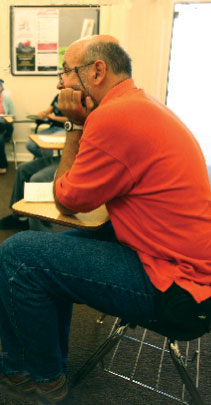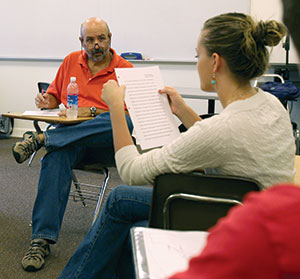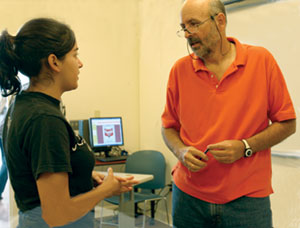Professor Bob Mayberry Teaches Students the 'Write' Way

“Art is what you can get away with.’ What does Andy mean by that,” asked Bob Mayberry to a room full of freshmen. “Write! Whatever comes to your mind, just write it down for the next three minutes, go!”
Mayberry is asking his students to jump-start their minds with an exercise that will trigger words to travel from the mind to where the pen or pencil touches the paper. Everyone in this classroom is writing, and for three minutes no one is staring back at Mayberry with a blank look on his or her face.
“They come into my class just out of high school knowing how to write a polished five-paragraph essay. I’m teaching them the process of writing,” Mayberry explained.
The process of writing is something Mayberry, associate professor of English and director of the Composition Program at CSUCI, knows well as it is one of his favorite pastimes. Along with his work as an instructor, Mayberry is a playwright who has published eight plays, most recently one in 2002 titled: “A Single Numberless Death,” which recounts the experiences of a woman who was captured by the secret police of the Argentine military junta during the Dirty Little War of the 1970s.
His teaching career began as a composition instructor at the University of Oklahoma in 1979, and over the years he has taught at seven other institutions before taking a position at CSUCI.
“Writing is fun like putting together a puzzle is fun,” he said with a smile.
While his students continue to write, Mayberry sits and quietly observes. He knows the value this quick writing exercise bears, and for three minutes nothing this crop of 18-year-olds writes will be the wrong answer.
Through this exercise and other assignments Mayberry is giving his students the tools they need to look at things differently. Watching his students, as they read aloud the third essay they have written in the early weeks of the semester, it seems like they are all still testing the boundaries of writing beyond the comfort zone of the five-paragraph essay. Mayberry concentrates on each student as he or she reads, and when he or she finishes reading he asks the student’s classmates questions about the piece.

There’s a group discussion. The writer of the piece that’s being talked about seems more relaxed with the input of his peers, and with the guidance of Mayberry the students suggest changes to his work that will make it stronger. All of this learning is accomplished without Mayberry scrawling notes in red pen in the margins of his students’ papers.
“The greatest thing I’ve learned about teaching composition is to sit on your hands the first time you read a student’s paper,” Mayberry said.
Though it’s contrary to every impulse teachers have, not marking student papers not only saves time but is consistent with decades of research showing that teacher corrections inhibit learning and teacher comments are usually ignored or misunderstood.
The group finishes doing its session of peer-reviews and Mayberry writes the next week’s worth of assignments on the white board. It’s a Thursday, and next Thursday the class has another essay due. He points at a copy of Andy Warhol’s famous painting of the Campbell’s Soup Can and for the assignment he asks his class to take a deeper look at the can and write about the deeper meanings—symbolic or otherwise—they find in the painting of the can.
“Do we have to come to a conclusion?” a student asks after a few moments of silence.
“No!” Mayberry exclaims energetically while lifting his arm and pointing at the soup can painting. “This isn’t high school writing.”
They all seem a little confused by Mayberry’s response. But he’s used to it. He nods and assures them that there isn’t a right or a wrong answer on the assignment, what’s important is to look critically at the painting, use the skills they glean from essays written by last year’s composition students and published in the composition program textbook, “Island Voices,” apply that knowledge when they look at the painting again, and then write about it.
Mayberry didn’t come up with this method of teaching composition overnight. He confesses to burning the midnight oil and scratching comments into the margins of many papers with a red pen early in his career. However, it was studying the research in the field that shifted his approach to grading papers and teaching composition, and one student who so misunderstood his marginal comments that her writing got much worse; she said Mayberry had made her hate writing.
Prior to his arrival at CSUCI in 2003, Mayberry wore a few hats at Grand Valley State University in Michigan. It was he and his colleagues who developed a process for students to self-assess their writing in order to make an informed choice between first-year composition courses that separate students based on their abilities.

When Mayberry arrived at CSUCI he led the English Composition Program’s creation of Directed Self-Placement. Unlike the other universities in the CSU system, CSUCI doesn’t use the English Placement Test—single timed essays—to decide how students will perform in composition courses; instead the Directed Self-Placement allows students to choose one of two composition courses that fit their own needs.
“The Directed Self-Placement program at CSUCI is a vast improvement over testing-based decisions and remedial writing courses,” said Mary Adler, assistant professor of English at CSUCI.
She explained that the program puts the student in control of his or her education. Rather than seeing their composition course as a remediation for their deficiencies, students who have made their own placement choices see it instead as an opportunity. They begin the class on a positive note and move forward from there.
“Bob has assembled an outstanding team of professionals to teach the composition courses. Under Bob’s leadership, they collaborate regularly and support one another and the students through holistic team scoring of common assignments and portfolios. This keeps the quality of teaching high and consistent across the program,” Adler said.
The final minutes of Mayberry’s class tick away and there’s time for one more three-minute writing exercise with the seed being another quote from Andy Warhol.
“‘Everybody will be famous for 15 minutes.’ Why 15 minutes?” Mayberry asks the class.
Heads bow and from his vantage point at the front of the classroom Mayberry can see his students’ hands move without stopping. About two minutes into the exercise notebooks are being flipped over and the backsides of pages are being filled. Mayberry is smiling.
“O.K. that was three minutes, and see, thinking is a relatively easy activity and so is writing,” he tells his students as class ends and they begin to leave. “Remember to ask why.”
